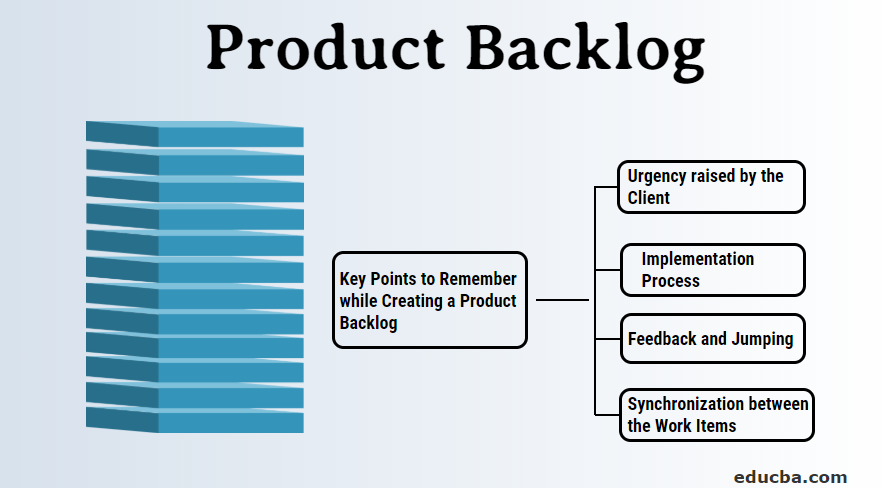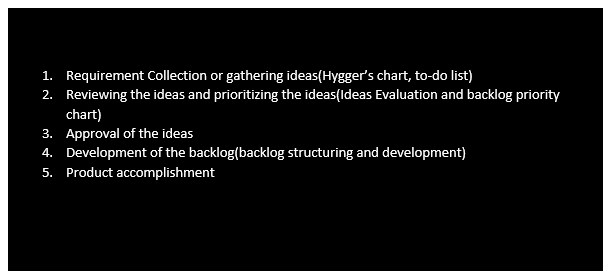Updated May 23, 2023
What is a Product Backlog?
Product Backlog can be defined as an organized or sorted list of all the required products necessary for delivering the output, with the source of the product changing continuously as per the project’s demand. The responsibility of the product backlog and product backlog management lies with the product owner, and the product owner has myriads of responsibilities related to product backlog like content and source of the product, availability of the product, prioritizing the product, bugs, technical works and maintaining the daily to-do list. It is an incremental list prepared by continuously adding the preliminary requirements and the other needs to the initial version of the product.
The product undergoes continuous changes during its evolution, and the process persists until the project reaches completion and the stakeholder or owner receives the delivered product. In other words, it is dynamic and changes the product development process. The backlog assessment makes the product reasonable, useful, and flaw-free as long as the product exists. It can be agile or scrum per the project’s requirement and the product owner.
Purpose
The backlog bridges the gap between the product owner and the development team. The product owner and the development team open up on a common communication platform to accomplish the product. The product owner must prioritize work in this backlog at any time per the feedback collected from the customers/clients and the new requirements. The development team then starts working according to the product backlog the owner provided. When the two product owners and the development team work are in sync, it helps boost focus and team morale. The changes should be kept minimum once the work is in progress to create fewer disruptions in the functioning of the development team.
Benefit/Merit
A well-organized product helps reduce the ambiguity of tasks and product updates among the team members and makes planning the next step easy. This helps to save a lot of time on the team, which can be utilized for other fruitful work. Furthermore, a good backlog helps to broadcast product updates to the team, which helps set the expectations right.
Key Points to Remember
There are two important cornerstones for product backlog development: roadmap and requirement. The roadmap, also known as a draft or outline, outlines the entire project and breaks it into several smaller segments known as epics. Each epic can encompass various user stories. The product owner organizes the user stories into a list, facilitating the development team’s work by making it more efficient and less time-consuming. The product owner then prioritizes the epic and can choose to deliver the complete epic. Several factors may affect the prioritization of the epic during product development, such as:
- Urgency raised by the client/customer.
- Implementation process.
- The urgency of collecting feedback and jumping onto the next iteration.
- Synchronization between the work items.
Template/Contents of a Product Backlog
Difference Between a Simple Task List and a Product Backlog
- It is incremental in nature and dynamic, which means that the upcoming requirements are being added to the initial version of the backlog.
- This values the customer’s feedback.
- The client or the customer suggests improvements; thus, constant updates are added.
- The items in the backlog are organized and prioritized per the customer’s needs.
- It grows rapidly and documents the agile or scrum to-do list.
- It contains no low-level tasks as the documentation becomes large and difficult to manage.
Maintaining
Maintaining this backlog is essential as continuous updates and improvements grow very rapidly. The product owner is responsible for regularly reviewing and maintaining the product to ensure this backlog is well organized and updated. The product owner must regularize these backlogs before moving to the next epic/iteration or phase. Suppose the backlog is not defined and prioritized before the next work plan meeting. In that case, it may lead to aborting the next phase creating chaos and confusion. Thus, it becomes necessary for the product owner to review the product every day or every alternate day.
- Maintaining this becomes necessary to avoid confusion regarding the next task. If the team fails to organize the items in the backlog effectively before the next phase, it could lead to the subsequent stage’s cancellation.
- Adhering to the Backlog task is also important to complete the current task. If other tasks and projects create disturbances or too many new items appear on the product, addressing those items on the backlog becomes necessary.
- Dedicate one part of the backlog to the new improvements and ideas and the other to the bugs detected in the created product eliminating the hustles and dilemmas. To simplify this backlog, assign an age limit to the ideas and scrap the ideas beyond that age limit.
Thus maintaining and reviewing it regularly will help you make the unmanageable colossus product into a manageable and structured outline/guideline. A lean and managed backlog will accelerate and catalyze product development, implement innovation, and achieve higher customer satisfaction. This will help you to deliver the best-of-class service possible.
Recommended Articles
This has been a guide to Product Backlog. Here we discuss the purpose, merit, key points, and difference between a simple task list and a product backlog. You can also go through our other suggested articles to learn more –




